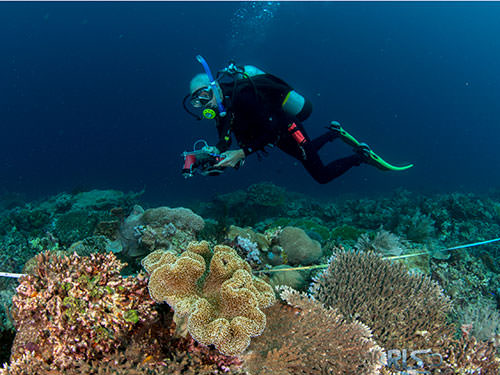At the end of August, a small team of RLS divers gathered for a strategically-located holiday to fill an important gap in the RLS database – Raja Ampat, the global centre of fish diversity.
Andrew Green, Bill Barker, Caroline Mason, Sue Baker and Sophie Edgar all made the journey to help Graham and Rick with the incredibly challenging reef surveys. The Raja Ampat Islands lie NW of Sorong in West Papua and are home to more than 1,500 fish species, more than anywhere else in the world. The team stayed on Kri Island, which offered a perfect base to explore the diverse array of reef habitats scattered amongst a maze of bays sheltered by forest-covered limestone peaks and divided by deep channels.

If the enormous number of fish species wasn’t enough to make the surveys sufficiently difficult, the currents at many sites certainly added to the fun! The high current channel sites were characterised by clear waters, steeply sloping coral slopes covered with soft corals and gorgonians. Counts of over 100 fish species per 50m transect were common at these sites, particularly when good hard coral cover occurred on top of the reef. Cape Kri was incredibly diverse, and surely has to be one of the world’s greatest dive sites. It has excellent macro life on the slope, with many smaller species recorded there that weren’t at any other sites, has beautiful hard coral gardens in 5 m depth on top, and comes to a point where two currents meet and shoals of pelagic fishes gather in the water column.
This is the reef where part of the world record fish count was made by Gerry Allen (374 species in a single 90 min dive) and had 140 fishes recorded on the shallower RLS transect and 232 fishes across the four transects surveyed. The only site at which more fishes were recorded on a single transect on this trip was the nearby Kri Eco Resort jetty, where the channel habitat met the edge of the shallow lagoon habitat and the jetty itself offered structure not found at any of the other reef sites. The RLS record of 148 fish species in M1 on a single transect was set here.
Sites in more sheltered bays offered relief from currents, but not from hours in the ID books at the end of each day! These habitats, which included unique coral-fringed mangrove shores and siltier reefs with lower coral diversity, were characterised by totally different fish faunas (with lots of gobies). Total fish richness was not as high as at the current-swept channel sites, which eased the data entry pain just a little.

Although the number of fishes on M1 was an obvious feature of surveys at Raja Ampat, species counts on M2 were also quite high for coral reefs. Although mostly consisting of cryptic fishes (e.g., 8 species of Ecsenius blenny, >12 species of Eviotaand > 4 Trimmagobies were recorded), there were plenty of crinoids and nudibranchs to keep the team honest.
All up, the stats were: 65 transects across 31 sites, 551 species recorded on M1, 233 on M2. The smallest species recorded was Hippocampus pontohi (pygmy seahorse ~5mm), the largestManta birostris. Not only was the RLS record set for the number of fish species on a single transect, but almost certainly the RLS record time spent entering data! Well done to the team on a challenging, but rewarding effort.
The team would sincerely like to thank Max Ammer and Tertius Kammeyer from the Raja Ampat Research & Conservation Centre and Kri Eco Resort. Well-oiled, but flexible logistics from Tertius facilitated the surveys of such a diverse range of sites, without hiccup, and the knowledge of the sites and marine life provided by Ullis, Dolvinus and Melki (who sometimes even assisted with laying and retrieving transect lines) was extremely valuable.
Andrew, Bill and Caroline also spent a week at the Biodiversity Eco Resort on Gam outside of the more formally organised surveys from Kri. With the interest and support of the resort owners, Andrew and Bill were able to complete an additional four transects.
